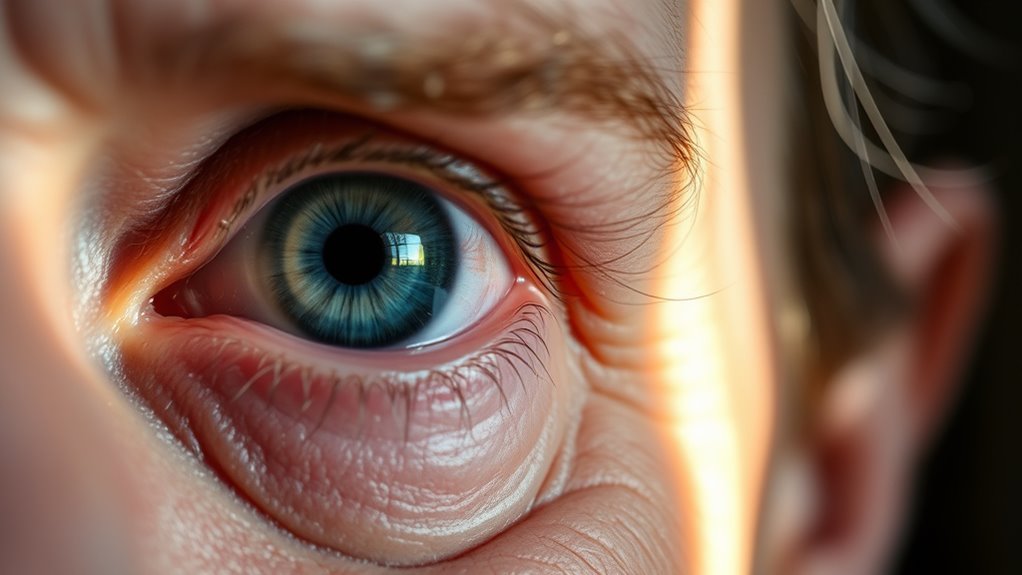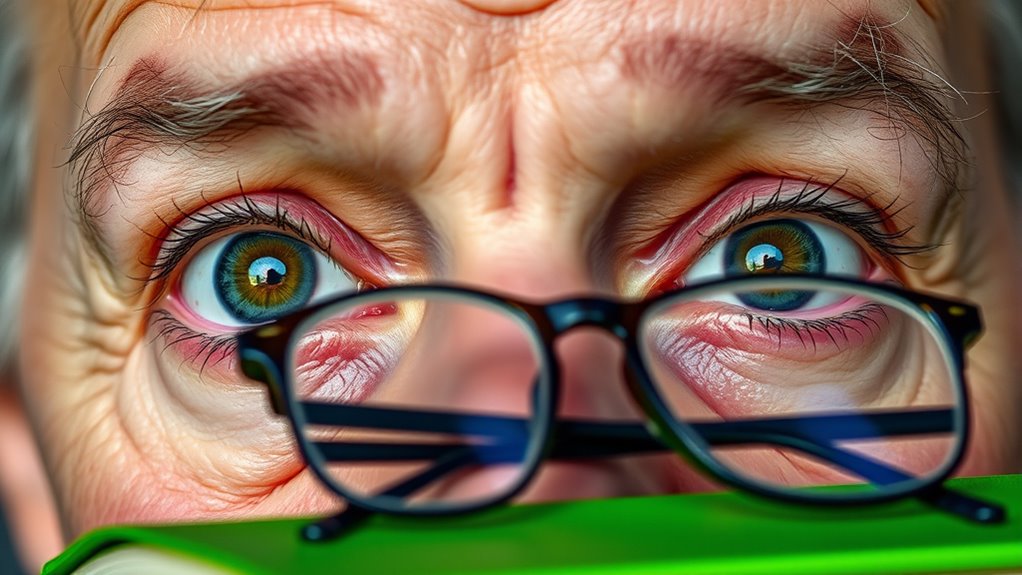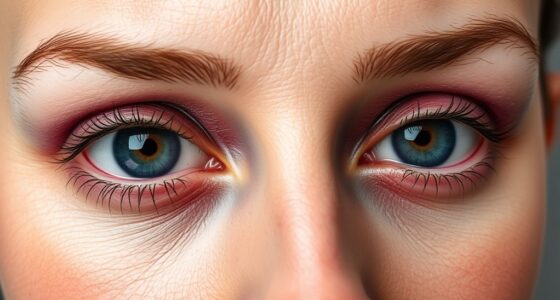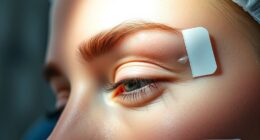As you age past 40, your eyes face challenges like presbyopia, dry eyes, and increased risk for cataracts and glaucoma. Regular eye exams are essential for early detection of these common problems. Watch for warning signs like blurry vision or increased floaters. To maintain eye health, eat a balanced diet, protect against UV rays, and practice the 20-20-20 rule during screen time. There’s more to discover about managing these changes effectively.
Key Takeaways
- Schedule regular eye exams every 1-2 years to catch age-related conditions early, ensuring timely treatment and management.
- Maintain a nutritious diet rich in vitamins A, C, E, zinc, and omega-3 fatty acids to support eye health.
- Protect your eyes from UV rays by wearing sunglasses and wide-brimmed hats when outdoors.
- Stay hydrated and follow the 20-20-20 rule to reduce eye strain during prolonged screen time.
- Be aware of warning signs like vision fluctuations, peripheral vision loss, and increase in floaters to seek prompt medical attention.
Understanding Age-Related Vision Changes

As you age, your vision naturally begins to change, often starting in your early to mid-40s. One common condition is presbyopia, where decreased lens flexibility makes it tough to focus on close objects, resulting in the need for reading glasses.
You may also experience dry eyes due to reduced tear production, especially if you’re a woman post-menopause. Night vision can deteriorate as aging photo receptors struggle in low light, increasing risks while driving at night.
Regular eye exams become essential after 40 to catch conditions like cataracts, glaucoma, and age-related macular degeneration early. These issues can lead to significant vision loss if left untreated, so schedule an all-encompassing eye examination to keep your vision sharp.
Common Vision Problems After 40

Many people notice that common vision problems emerge after turning 40, making it vital to stay vigilant about eye health.
One major issue is presbyopia, where lens rigidity hampers your ability to focus on close objects, often requiring reading glasses for clear vision.
Cataracts also become more prevalent, causing blurry vision and light sensitivity.
You should be aware of glaucoma, which can silently damage your optic nerve, leading to peripheral vision loss if untreated.
Age-related macular degeneration (AMD) affects central vision, resulting in blurred or distorted sight.
Additionally, dry eye syndrome, caused by decreased tear production, can lead to irritation and blurred vision, especially after long periods of reading or screen time.
Regular eye exams are essential for early detection and management.
Importance of Regular Eye Exams

Regular eye exams are vital for maintaining your vision health, especially after you turn 40. The importance of these exams lies in early detection of age-related conditions like cataracts and macular degeneration. Detailed eye examinations every 1-2 years can help you monitor chronic conditions that could affect your vision, such as diabetes and high blood pressure. Regular checks can prevent serious vision loss, ensuring you enjoy clear sight for years to come. Additionally, the importance of regular check-ups cannot be overstated, as they play a crucial role in managing overall health and catching potential issues early.
| Exam Type | Purpose |
|---|---|
| Visual Acuity Tests | Assess how well your vision functions |
| Slit-Lamp Examinations | Identify potential issues in eye structures |
| Dilated Eye Exams | Thorough assessment of lens and retina |
| Early Detection | Essential for managing eye diseases |
Warning Signs of Eye Health Issues

As you age, pay close attention to any fluctuations in your vision, as they might point to health issues like diabetes or hypertension.
Additionally, keep an eye out for signs of glaucoma, such as a gradual loss of peripheral vision, which can often go unnoticed until it’s too late.
Recognizing these early warning signs is essential for maintaining your eye health.
Fluctuating Vision Indicators
Have you noticed your vision changing unexpectedly? Fluctuating vision can be a warning sign of underlying health issues that shouldn’t be ignored.
Here are three key indicators to watch for:
- Increased floaters or flashes of light may signal retinal tears or detachments; consult an eye specialist immediately.
- Loss of peripheral vision could hint at glaucoma, potentially leading to significant vision loss if not diagnosed early.
- Distorted images or blind spots are common symptoms of age-related macular degeneration (AMD), which can progress without noticeable signs.
Regular eye exams are essential for detecting these warning signs early.
Signs of Glaucoma
What signs should you look for when it comes to glaucoma? Glaucoma is often sneaky, with many individuals experiencing no noticeable symptoms initially.
You might notice peripheral vision loss, which can indicate increased pressure in the eye damaging the optic nerve. If you see halos around lights or experience eye pain and redness, it could signal acute angle-closure glaucoma, a serious condition that needs immediate care.
Since the risk of developing glaucoma increases after 40, especially with a family history, regular eye exams are essential for early detection. These exams include pressure testing and an evaluation of the optic nerve, helping to safeguard your vision.
Don’t wait—stay proactive about your eye health!
Tips for Maintaining Eye Health

Maintaining eye health becomes increasingly important after 40, especially as age-related conditions can develop. To keep your vision sharp, consider these tips:
- Schedule Regular Eye Exams: Get eye exams every 1-2 years for early diagnosis of conditions like cataracts and macular degeneration.
- Adopt a Nutritious Diet: Include vitamins A, C, E, zinc, and omega-3 fatty acids in your meals, focusing on leafy greens, citrus fruits, nuts, and fatty fish to support eye health. A diet high in whole foods can also improve overall well-being and enhance nutrient intake.
- Protect Against UV Rays: Wear sunglasses that block 100% of UV light and wide-brimmed hats outdoors to reduce cataract risk.
Also, stay hydrated and practice the 20-20-20 rule during screen time to minimize eye strain. Incorporating hydration and nutrition into your daily routine can significantly contribute to better eye health.
Prioritizing these habits will enhance your overall eye health.
Managing Dry Eyes Effectively

As you reach your 40s, you might notice dry eyes becoming a common issue, often caused by hormonal changes and decreased tear production.
Understanding the causes can help you find effective treatment options that relieve discomfort.
Let’s explore how to manage dry eyes effectively and improve your overall eye health.
Causes of Dry Eyes
Dry eyes can affect millions of people, especially those over 40, due to various factors that contribute to the condition. Here are three common causes:
- Hormonal Changes: Decreased tear production, particularly in women after menopause, leads to discomfort and irritation.
- Environmental Factors: Dry climates, indoor heating, and extensive screen time reduce your blink rate, worsening dry eye symptoms.
- Age-Related Changes: As you age, your eyes naturally produce less lubrication, making dry eyes more prevalent.
To manage dry eyes effectively, consider using over-the-counter lubricating drops, making dietary adjustments like increasing water and omega-3 fatty acid intake, and scheduling regular eye exams with an eye care professional for tailored advice.
Treatment Options Available
If you’re experiencing discomfort from dry eyes, several treatment options can help restore comfort and improve your quality of life.
Prescription eyedrops like Restasis or Xiidra can stimulate tear production, offering relief for chronic dryness. For milder cases, over-the-counter lubricating drops provide immediate comfort.
Don’t forget the importance of lifestyle adjustments; taking breaks from screens using the 20-20-20 rule can greatly reduce strain on your eyes. You might also consider increasing your water intake and including omega-3 fatty acids in your diet through foods like salmon or flaxseeds to boost tear production.
Finally, consult your eye doctor for personalized advice and to discuss environmental modifications, such as using a humidifier, to enhance your overall eye health and vision.
Recognizing and Treating Cataracts

Cataracts, which often develop gradually, can greatly impact your vision without you even realizing it. Nearly half of Americans over 75 experience this clouding of the lens, leading to blurred or dim vision.
Recognizing the symptoms early is vital. Here are three key signs to watch for:
Early recognition of symptoms is crucial; watch for these three key signs of cataracts.
- Difficulty seeing at night – You might notice increased trouble in low-light conditions.
- Sensitivity to light and glare – Bright lights may become overwhelming, making it hard to see clearly.
- Halos around lights – You may start seeing rings around lights, especially at night.
To address cataracts, regular eye exams with your eye doctor are essential. If diagnosed early, treatment often involves a minimally invasive surgery that can restore your vision effectively.
Protecting Your Eyes From Glaucoma

After addressing the impact of cataracts on vision, it’s important to turn your attention to another serious eye condition: glaucoma.
This group of conditions damages your optic nerve, often due to increased intraocular pressure. Starting at age 40, you should schedule annual eye exams that include pressure testing and an optic nerve examination. This will help detect glaucoma early, as symptoms usually go unnoticed until significant vision loss occurs.
Be aware of risk factors like family history, diabetes, and high blood pressure. Treatment options often involve prescription eye drops to lower eye pressure, with surgery available if necessary.
Maintaining a healthy lifestyle, including regular exercise, can further reduce your risk and support your overall eye health.
Frequently Asked Questions
Is It Possible to Improve Eyesight After 40?
Yes, it’s definitely possible to improve your eyesight after 40!
You can start by scheduling regular eye exams to catch any issues early. Consider using prescription glasses or contact lenses for clarity.
Nutritional changes, like adding vitamins A, C, E, and omega-3s to your diet, can support eye health.
Staying hydrated and managing screen time with the 20-20-20 rule can also alleviate discomfort and help maintain your vision.
What Happens to Your Eyes at Age 40?
At age 40, your eyes start to feel like an old camera losing its focus. You’ll notice it’s tougher to read small print, and dry eyes might become a frequent nuisance.
The vibrant colors and contrasts you once enjoyed may dull in low light, making it harder to distinguish things. Plus, the risk of cataracts creeps up, blurring your vision.
Regular eye exams become more essential to catch these changes early and maintain clarity.
Why Did My Eyes Get Better With Age?
Your eyes might seem to get better with age due to natural changes in the lens and eye muscles.
As these structures stiffen, they can sometimes reduce nearsightedness, improving your distance vision.
You may also notice that your pupils respond differently to light, enhancing clarity in bright conditions.
These adjustments can lead to a surprising improvement in your ability to focus on faraway objects, reducing your reliance on glasses for distance vision.
Can I Reverse Aging Eyes?
You can’t completely reverse aging eyes, but you can take steps to support their health.
Eating a diet rich in antioxidants and omega-3 fatty acids helps. Regular eye exams let you catch issues early, while vision correction options can enhance clarity.
Protecting your eyes from UV rays and staying hydrated can prevent dryness. Don’t forget to practice the 20-20-20 rule and engage in eye exercises to relieve strain from screens.
Conclusion
As you navigate the world after 40, keeping your eyes sharp is essential. Regular eye exams and staying alert to warning signs can make a world of difference. By managing dry eyes, recognizing cataracts, and protecting yourself from glaucoma, you can maintain your vision like a hawk. Remember, your eyes are the windows to your soul, so don’t let them fade! Prioritize your eye health today, and you’ll see the world with clarity for years to come.









